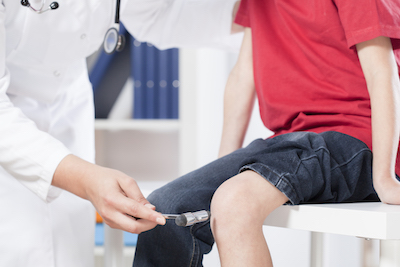Tips to make your kid's sport season a safer one
Kids are back in school and back in sports. When I was younger, that always meant balancing the less-than-happy feelings of returning to a sleep schedule with my excitement over returning to organized sports. Sports were always a fun way for me to stay active, learn to work within a team and to build friendships.
Many years later, I would come to realize that my parents and I had very different feelings about the return of sports season. I was excited and ready to give anything a try, while my parents were often worried about when my next injury would come or if there was anything else they could do to protect me.
So with that thought in mind, here are some helpful tips for a safer sports season.
What should I do before my child starts playing sports?
First, you should always consider your child’s age, maturity and which activities they enjoy so you can come to an agreement about which sports would be a good choice for them.
- Children ages two to five are still developing in terms of basic movements and vision. Often, basic activities such as running, swimming, throwing and catching are better choices than an organized sport.
- Children ages six to nine are continuing to develop and are better able to follow directions, but are often not able to handle complex sports skills. Activities such as tennis, soccer, swimming, t-ball and martial arts are good choices.
- Children older than 10 are better able to do complex sports skills often required in football, hockey and basketball. The decision to start contact sports should always include consideration of your child’s physical stature and maturity in relation to other children of the same age to help prevent injuries.
 Second, you should take your child to a medical professional for a pre-participation sports physical about six weeks before the start of any sport. The goal of a sports physical is to provide an opportunity to uncover any treatable medical conditions and to help prevent future injuries. Remember, it is always okay to ask any questions and discuss any concerns you have may with the medical professional.
Second, you should take your child to a medical professional for a pre-participation sports physical about six weeks before the start of any sport. The goal of a sports physical is to provide an opportunity to uncover any treatable medical conditions and to help prevent future injuries. Remember, it is always okay to ask any questions and discuss any concerns you have may with the medical professional.
Is there anything I can do to prevent injuries to my child?
Proper nutrition and sleep are very important not only in helping your child perform to the best of their abilities, but also in helping them recover after participation. A healthy diet should consist of a variety of fresh fruits and vegetables, whole grains, low-fat dairy, and lean protein found in chicken, turkey and fish.
- Your child should also have a consistent sleep schedule with eight to 10 hours of uninterrupted sleep.
- Be sure to inspect equipment and shoes prior to playing to ensure they fit properly and are in good condition.
- You should also get to know your child’s coaches to ensure they are knowledgeable about your child’s individual abilities and needs.
Are there any concerning signs or symptoms of injuries I should be aware of?
Some children do not always tell when they are injured for fear they will not be able to play, so it is important to recognize some common symptoms of injuries.
Many common injuries result from repetitive overuse of certain muscles or joints. Symptoms include pain, swelling, bruising, decreased interest in playing/practicing or limited ability to move the affected area.
Another common injury that is receiving more attention is head injuries or concussions. Common symptoms include headaches, confusion, nausea, vomiting, dizziness, loss of memory and mood changes. These symptoms can often last for weeks or months depending on the severity of the injury and the individual. If you suspect your child is injured, it is important to rest your child from physical activity and to seek an evaluation by a medical professional.
My child is in pain. What should I do?
Rest, Ice, Compression and Elevation are often very helpful in reducing pain.
Rest
If your child is in pain and continues activities, they can often make the pain worse or further injure themselves, so it is always important that your child rests from physical activity.
Ice
Ice is important in the first 48 to 72 hours after an injury occurs to help reduce swelling and pain. You should apply ice to the affected area about 15 to 20 minutes at a time.
Compression
Compression such as a brace or tape can be used in between times when ice is used.
Elevation
Keeping the affected area elevated to reduce pain and swelling also can prove helpful.
You may also give your child children’s ibuprofen or children’s acetaminophen according to the directions on the box. These medicines are available over-the-counter at most pharmacies, but be sure you ask your doctor or pharmacist if you are unsure of the correct dosage.
It is also important that your child receives an evaluation by a medical professional if your child is in pain. If the pain is severe or you suspect a severe injury, you should seek immediate medical attention.
Sports are a great opportunity to learn new skills while building both new and old friendships. I will always have great memories to look back on from sports, and I hope you can use these suggestions to help make this upcoming sport season safe and fun for your child so they can create their own memories.






